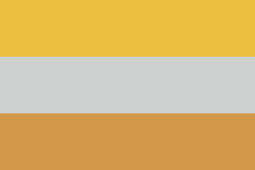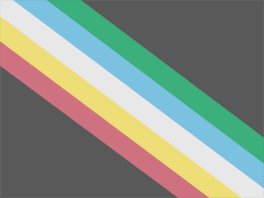 | |
| Disability flag | |
| Use | Symbol of the Disability community |
|---|---|
| Proportion | 3:5 |
| Adopted | 2017 |
| Design | Tricolour with three equally sized horizontal stripes of gold, silver, and bronze |
| Designed by | Eros Recio |
| Disability |
|---|
| Theory and models |
| Education |
| Therapy |
| Societal implications |
| Personal assistance |
| Socioeconomic assistance |
|
| Parasports |
| Culture |
The disability flag, overcoming flag or Flag of the Rights of Persons with Disabilities is a flag that represents people who have disabilities. It was created by the Valencian dancer Eros Recio in 2017 and then presented to the United Nations. The flag is meant for general use, particularly at disability-centered events. It has been used at the International Day of Persons with Disabilities.
Design and meaning
The flag is intended to represent people with disabilities, their struggle for rights, and related concepts including the disability pride movement and the Paralympic Games.
The flag is a tricolour flag with three equally-sized horizontal stripes of gold, silver, and bronze. These colours are meant to evoke the three medals at the Paralympic Games, and are intended to represent the collective's overcoming of obstacles, rather than the competitive and meritocratic sentiments related to the event itself. For example, discriminatory adversities imposed by society, the victory of new rights achieved for the collective, and a celebration of increased awareness of social inequality. According to Recio, the three colours also represent the different forms of disability. However, the meanings of these colours are intended to be decided by the collective community they represent.
History
On December 3, 2017, at the United Nations' International Day of Persons with Disabilities, parliamentarians from Latin American countries gathered in a plenary assembly in Peru. By acclamation, they declared the flag to be the symbol of all people with disabilities. On the same day, the flag was handed over to the European headquarters of the United Nations. Many Spanish cities and municipalities display the flag on the International Day of People with Disabilities. In 2018, the flag was shown in the city of Santa Cruz de La Palma on the Canary Island of La Palma. On December 3, 2018, the flag was adopted by the "Foment d'Esportistes amb Reptes" (FER), an Olympic and Paralympic sports organization in Spain.
Influence of "Disability Pride"

The Disability Pride flag represents the Disability Pride Movement. Its origin is in English-speaking countries, where the movement's presence is greater. The original Disability Pride flag was created in 2019 by Ann Magill, a disabled woman, and featured a zig-zag or lightning bolt design but after receiving input from people with visually triggering disabilities, the flag was changed in 2021 to have muted colors and straight diagonal stripes. Certain events and celebrations include Disability Pride Month, Disability Pride Week, and the parades for both events.
The movement has its roots in pride awareness events for other minority communities. The concept and design of the Disability Pride Flag were also inspired and influenced by social movements such as LGBT pride and Black pride.
The first Disability Pride Parade in the United States was held in Boston, Massachusetts, in 1990. Since then, disability pride parades have spread throughout the country. Parades have also occurred in Norway, the United Kingdom, South Korea, and Germany.
The Chicago Disability Pride Parade outlines these goals in its statement:
- Change the way people think and define "disability".
- Break and end internalized shame among people with disabilities.
- Promote the idea in society that disability is a natural and fundamental part of human diversity that people living with disabilities can be proud of.
These ideas inspired the flag that is meant to represent the collective in a universal and globalized way, not just at Disability Pride events.
Relationship with Eros Recio
According to Eros Recio, the flag is designed with the colors of three metals: gold, silver, and bronze. These are meant to represent the three main types of disability: physical, mental (intellectual or psychosocial), and sensory. The flag and its design have a general nature, meaning that each color does not exclusively represent a specific type of disability, but rather all of them as a whole. Nor does it mean that it excludes other forms of disability, such as visceral disability, or multiple disabilities. It is important to mention that no color is considered more important than another.
On December 12, 2019, Eros Recio participated in an official act of the College of High Silk Art of Valencia, in which a Disability Flag made of silk was added to the exhibition. On this occasion, Recio reiterated his statement in a speech that this flag represents all people with disabilities.
During the act, the incorporation of a new definition for the flag was mentioned: "Flag of Overcoming". This was to highlight the vindictive character of the term "disability" and avoid possible social segregation typical of ableism.
See also
- Disability – Impairments, activity limitations, and participation restrictions
- Disability Pride Month – ObservancePages displaying short descriptions with no spaces
- Disability rights movement – Social movement seeking equal rights for disabled people
- Disability Studies – Academic discipline examining the meaning, nature, and consequences of disability
- Disability in the arts – Inclusive practices involving disability
- Functional diversity – Term for handicapped people
- Mad Pride – Movement encouraging pride in people with mental illnessesPages displaying short descriptions of redirect targets
- People-first language – Putting the person before the diagnosis
References
- ^ "La bandera de las personas con discapacidad". ABC Blogs (in Spanish). 17 December 2017. Retrieved 8 March 2021.
- ^ R. D. (3 December 2018). "El Proyecto FER apadrina la bandera de la discapacidad". Las Provincias (in Spanish). Retrieved 8 March 2021.
- "ABBE – La bandera de las personas con discapacidad". www.abbe.es. Retrieved 12 April 2021.
- "Exaltación de la Bandera de la Superación y la Discapacidad". Noticias sobre discapacidad, dependencia y salud (in Spanish). 15 December 2019. Retrieved 12 April 2021.
- "La bandera de la discapacidad ya 'ondea' en el fondo del mar". Ideal (in Spanish). 3 August 2019. Retrieved 12 April 2021.
- ^ "Las bandera de la discapacidad". rehatrans.com (in European Spanish). Retrieved 12 April 2021.
- "I Encuentro Latinoamericano de Discapacidad, Cultura y Responsabilidad Social". Puntos de Cultura (in Spanish). Retrieved 31 March 2021.
- ^ "Las bandera de la discapacidad". rehatrans.com (in European Spanish). Retrieved 31 March 2021.
- Rodriguez Gonzalez, Roman (2009), "Ayuntamiento de Deza", Reformar la Administracion Territorial. Municipios eficientes y viables, Netbiblo, pp. 201–230, doi:10.4272/978-84-9745-271-7.ch10, ISBN 978-84-9745-271-7, retrieved 31 March 2021
- "Qué es". Proyecto FER (in European Spanish). Retrieved 31 March 2021.
- "Observing Disability Pride Month this July". Human Rights Watch. 2022-07-22. Retrieved 2022-07-28.
- "Disability Pride Month 2022". Bracknell Forest Council. 29 June 2022. Retrieved 2022-07-28.
- "Disability Pride Month". Inclusive Employers. Retrieved 2022-07-28.
- R. Bogart, Kathleen (2021-07-01). "Disability Pride Month: Disability Is Broader Than You Think". Psychology Today Canada. Retrieved 2022-07-28.
- "Disability Pride Flag: everything you need to know". URevolution. 2 July 2018. Retrieved 2022-07-28.
- Italy, U. S. Mission (2022-07-25). "Disability Pride Month celebrates Americans with Disabilities Act anniversary". U.S. Embassy & Consulates in Italy. Retrieved 2022-07-28.
- "July Is Disability Pride Month". SBU News. 2022-07-06. Retrieved 2022-07-28.
- "What is Disability Pride... And How to Display It". www.ameridisability.com. Retrieved 12 April 2021.
- Goering, Sara (11 April 2015). "Rethinking disability: the social model of disability and chronic disease". Current Reviews in Musculoskeletal Medicine. 8 (2): 134–138. doi:10.1007/s12178-015-9273-z. ISSN 1935-973X. PMC 4596173. PMID 25862485.
- Torán, E. (12 December 2019). "Una bandera de seda valenciana por la Superación y la Discapacidad". 7TeleValencia (in European Spanish). Retrieved 12 April 2021.
- "Bandera de la Superación y la Discapacidad en el Museo de la Seda". Museo y Colegio de arte Mayor de la Seda Valencia (in European Spanish). 12 December 2019. Retrieved 12 April 2021.
- ^ "La bandera de la superación". www.actualidadfallera.es (in European Spanish). Retrieved 12 April 2021.